雅思A类小作文范文 produce electricity 流程图类
- 格式:doc
- 大小:12.00 KB
- 文档页数:1
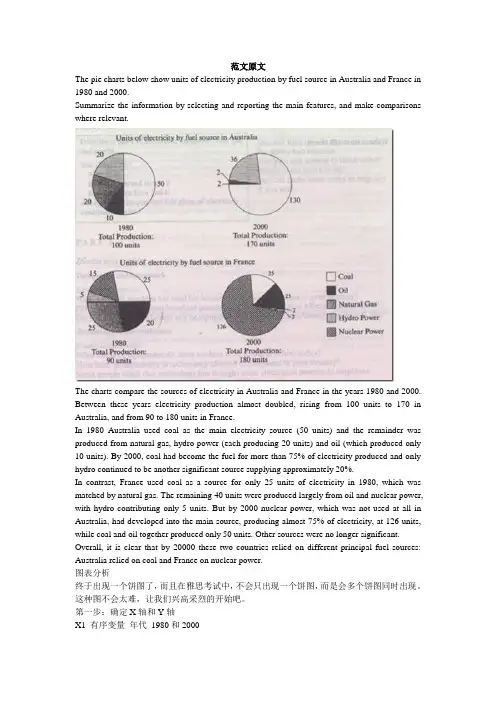
范文原文The pie charts below show units of electricity production by fuel source in Australia and France in 1980 and 2000.Summarize the information by selecting and reporting the main features, and make comparisons where relevant.The charts compare the sources of electricity in Australia and France in the years 1980 and 2000. Between these years electricity production almost doubled, rising from 100 units to 170 in Australia, and from 90 to 180 units in France.In 1980 Australia used coal as the main electricity source (50 units) and the remainder was produced from natural gas, hydro power (each producing 20 units) and oil (which produced only 10 units). By 2000, coal had become the fuel for more than 75% of electricity produced and only hydro continued to be another significant source supplying approximately 20%.In contrast, France used coal as a source for only 25 units of electricity in 1980, which was matched by natural gas. The remaining 40 units were produced largely from oil and nuclear power, with hydro contributing only 5 units. But by 2000 nuclear power, which was not used at all in Australia, had developed into the main source, producing almost 75% of electricity, at 126 units, while coal and oil together produced only 50 units. Other sources were no longer significant. Overall, it is clear that by 20000 these two countries relied on different principal fuel sources: Australia relied on coal and France on nuclear power.图表分析终于出现一个饼图了,而且在雅思考试中,不会只出现一个饼图,而是会多个饼图同时出现。
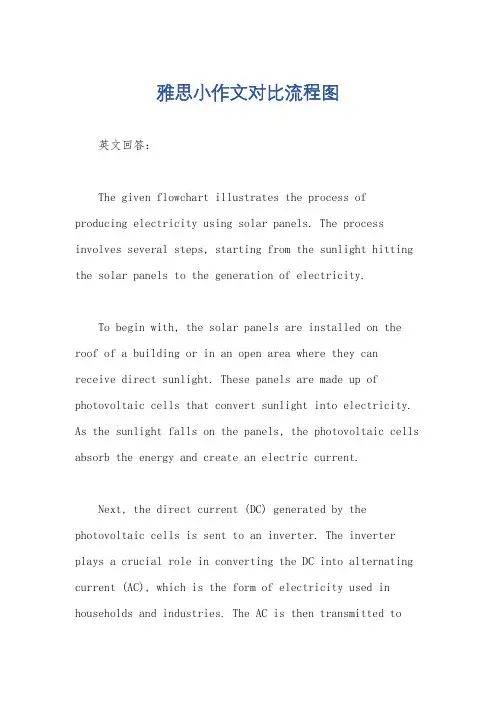
雅思小作文对比流程图英文回答:The given flowchart illustrates the process of producing electricity using solar panels. The process involves several steps, starting from the sunlight hitting the solar panels to the generation of electricity.To begin with, the solar panels are installed on the roof of a building or in an open area where they can receive direct sunlight. These panels are made up of photovoltaic cells that convert sunlight into electricity. As the sunlight falls on the panels, the photovoltaic cells absorb the energy and create an electric current.Next, the direct current (DC) generated by the photovoltaic cells is sent to an inverter. The inverter plays a crucial role in converting the DC into alternating current (AC), which is the form of electricity used in households and industries. The AC is then transmitted tothe electrical grid or stored in a battery for later use.After the conversion of DC to AC, the electricity is ready to be used. It can either be directly consumed by the building where the solar panels are installed or can be fed back into the electrical grid. When the electricity is fed back into the grid, it can be utilized by other buildings or facilities in the vicinity.In conclusion, the process of producing electricity using solar panels involves the absorption of sunlight by photovoltaic cells, conversion of DC to AC by an inverter, and the utilization of electricity either by the building or by feeding it back into the electrical grid.中文回答:这个给定的流程图展示了使用太阳能电池板发电的过程。
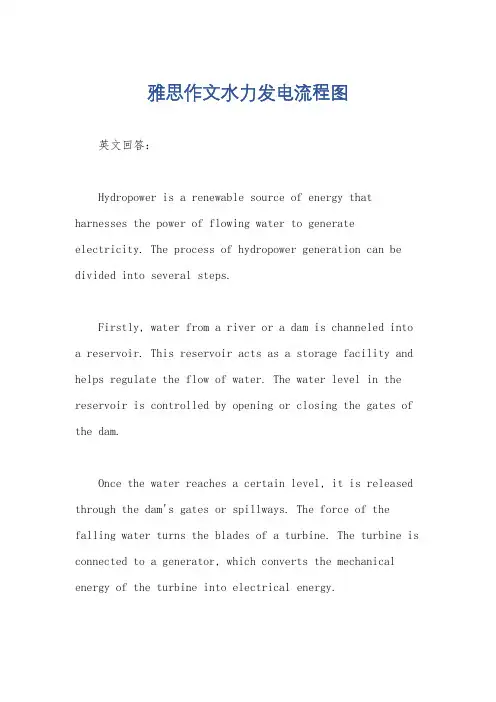
雅思作文水力发电流程图英文回答:Hydropower is a renewable source of energy that harnesses the power of flowing water to generate electricity. The process of hydropower generation can be divided into several steps.Firstly, water from a river or a dam is channeled into a reservoir. This reservoir acts as a storage facility and helps regulate the flow of water. The water level in the reservoir is controlled by opening or closing the gates of the dam.Once the water reaches a certain level, it is released through the dam's gates or spillways. The force of the falling water turns the blades of a turbine. The turbine is connected to a generator, which converts the mechanical energy of the turbine into electrical energy.The electricity generated by the generator is then transmitted through power lines to homes, businesses, and industries. It can be used to power appliances, lighting, and machinery, among other things.One example of a hydropower plant is the Hoover Dam in the United States. The dam is built on the Colorado River and has a capacity to generate over 2,000 megawatts of electricity. The water from the river is stored in Lake Mead, which acts as a reservoir. When the water is released from the dam, it flows through the turbines, generating electricity.中文回答:水力发电是一种利用流动水的能量来发电的可再生能源。
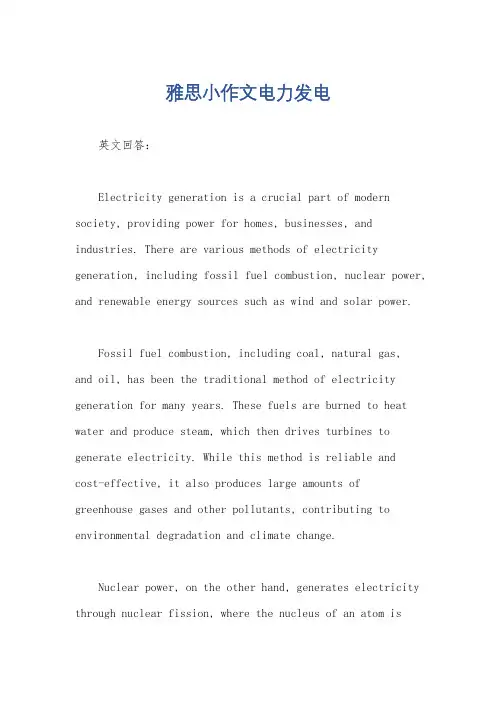
雅思小作文电力发电英文回答:Electricity generation is a crucial part of modern society, providing power for homes, businesses, and industries. There are various methods of electricity generation, including fossil fuel combustion, nuclear power, and renewable energy sources such as wind and solar power.Fossil fuel combustion, including coal, natural gas,and oil, has been the traditional method of electricity generation for many years. These fuels are burned to heat water and produce steam, which then drives turbines to generate electricity. While this method is reliable andcost-effective, it also produces large amounts of greenhouse gases and other pollutants, contributing to environmental degradation and climate change.Nuclear power, on the other hand, generates electricity through nuclear fission, where the nucleus of an atom issplit to release energy. This method is highly efficient and produces large amounts of electricity without greenhouse gas emissions. However, it also presents significant safety and waste management challenges, as well as concerns about the potential for nuclear accidents and the proliferation of nuclear weapons.Renewable energy sources, such as wind and solar power, are gaining popularity as alternatives to traditional electricity generation methods. Wind turbines convert the kinetic energy of the wind into electricity, while solar panels harness the energy of sunlight. These methods produce clean, renewable energy without greenhouse gas emissions, making them environmentally friendly options for electricity generation. However, they also depend on weather conditions and require significant initial investment in infrastructure.中文回答:电力发电是现代社会的重要组成部分,为家庭、企业和工业提供动力。
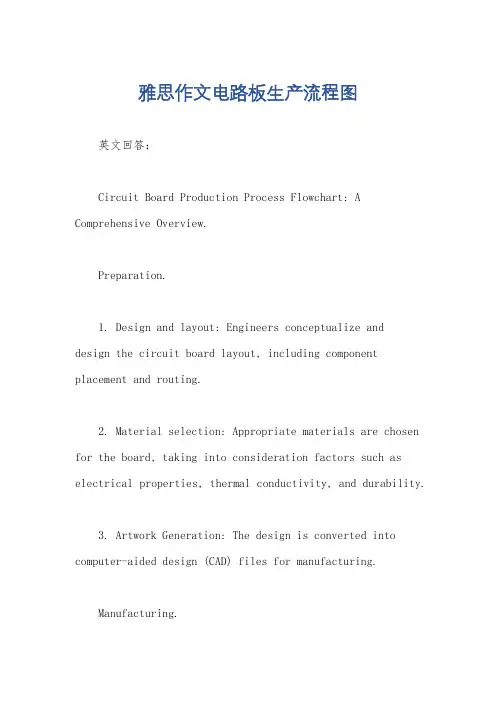
雅思作文电路板生产流程图英文回答:Circuit Board Production Process Flowchart: A Comprehensive Overview.Preparation.1. Design and layout: Engineers conceptualize anddesign the circuit board layout, including component placement and routing.2. Material selection: Appropriate materials are chosen for the board, taking into consideration factors such as electrical properties, thermal conductivity, and durability.3. Artwork Generation: The design is converted into computer-aided design (CAD) files for manufacturing.Manufacturing.1. Fabrication:Photolithography: A photosensitive layer is applied to the base material, and UV light is used to expose specific areas based on the CAD files.Etching: Exposed areas are etched away, leaving the desired copper circuitry.2. Drilling: Holes are drilled into the board for component mounting and interconnections.3. Plating: Copper plating is applied to the exposed circuitry to enhance conductivity and solderability.4. Solder Mask Application: A protective solder mask is applied to the board, leaving exposed areas for soldering components.5. Silkscreen Printing: Component reference numbers and other markings are printed on the board.Assembly.1. Component Placement: Electronic components areplaced on the board using automated pick-and-place machines or manual assembly.2. Soldering: Components are soldered to the boardusing various techniques, including wave soldering, reflow soldering, and hand soldering.3. Inspection and Testing: Automated optical inspection (AOI) and electrical tests are performed to ensure theboard meets quality standards and specifications.4. Programming: Firmware or software may be programmed into programmable devices on the board.Finishing.1. Conformal Coating: A protective coating is appliedto the board to enhance resistance to environmental factors,such as moisture and corrosion.2. Packaging: The completed circuit board is packaged for storage or shipment.中文回答:电路板生产流程图,全方位概述。
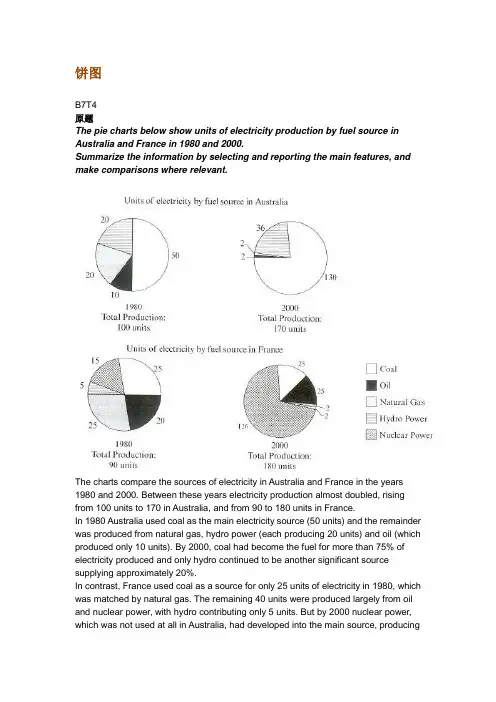
饼图B7T4原题The pie charts below show units of electricity production by fuel source in Australia and France in 1980 and 2000.Summarize the information by selecting and reporting the main features, and make comparisons where relevant.The charts compare the sources of electricity in Australia and France in the years 1980 and 2000. Between these years electricity production almost doubled, rising from 100 units to 170 in Australia, and from 90 to 180 units in France.In 1980 Australia used coal as the main electricity source (50 units) and the remainder was produced from natural gas, hydro power (each producing 20 units) and oil (which produced only 10 units). By 2000, coal had become the fuel for more than 75% of electricity produced and only hydro continued to be another significant source supplying approximately 20%.In contrast, France used coal as a source for only 25 units of electricity in 1980, which was matched by natural gas. The remaining 40 units were produced largely from oil and nuclear power, with hydro contributing only 5 units. But by 2000 nuclear power, which was not used at all in Australia, had developed into the main source, producingalmost 75% of electricity, at 126 units, while coal and oil together produced only 50 units. Other sources were no longer significant.Overall, it is clear that by 20000 these two countries relied on different principal fuel sources: Australia relied on coal and France on nuclear power.分析:题目The pie charts below show units of electricity production by fuel source in Australia and France in 1980 and 2000.•文章谈到的四个要素:units of electricity production, fuel source, Australia and France, 1980 and 2000第一段The charts compare the sources of electricity in Australia and France in the years 1980 and 2000.•四个要素也不能少: sources, electricity, Australia and France, 1980 and 2000 •这次我们也试着将名词性短语改成一个句子, The charts indicate how many units of electricity were produced by different fuel sources in Australia and Francebetween 1980 and 2000.Between these years electricity production almost doubled, rising from 100 units to 170 in Australia, and from 90 to 180 units in France.•说明两个国家从1980到2000的总量的变化•比较一下两个double的用法Ø double [vi]: Electricity production almost doubled.Ø double [vt]: The two countries doubled their electricity production.Ø 这两种用法在雅思图表作文中都很常用,注意一下第二段In 1980 Australia used coal as the main electricity source (50 units) and the remainder was produced from natural gas, hydro power (each producing 20 units) and oil (which produced only 10 units).•说明了澳大利亚1980年情况,•注意同义表达use…as the source, be produced fromBy 2000, coal had become the fuel for more than 75% of electricity produced and only hydro continued to be another significant source supplying approximately 20%.•说明了澳大利亚2000年的情况,注意此处引用了百分数,而非绝对值•这里采用了fuel作为了表达的主语,如Coal had become the fuel, Hydro continued to be another source.第三段In contrast, France used coal as a source for only 25 units of electricity in 1980, which was matched by natural gas. The remaining 40 units were produced largely from oil and nuclear power, with hydro contributing only 5 units.•说明法国1980年的情况•类似于1980年澳大利亚的表达:use…as a source, be produced fromBut by 2000 nuclear power, which was not used at all in Australia, had developed into the main source, producing almost 75% of electricity, at 126 units, while coal and oil together produced only 50 units. Other sources were no longer significant.•说明了法国2000年的情况•类似于2000年澳大利亚的表达:nuclear had developed into the main source第四段Overall, it is clear that by 20000 these two countries relied on different principal fuel sources: Australia relied on coal and France on nuclear power.上文谈到了1980年和2000年两国的发电总量变化(年代变化),这里谈到2000年两国的主要依赖能源(国家对照)词汇句型积累雅思图表作文基本功主要考察的是同义表达,如下面的这句话,就会有多种表达•Australia used coal as the main electricity source•Coal was the main source for electricity in Australia.•The main proportion of electricity was produced from coal in Australia.•Coal became the main fuel to produce electricity in Australia.这个句子中有几个要素coal, electricity, Australia, 你只要将这几个要素所作的句子成分发生变化,句式就会呈现多样性,同义多样表达必须掌握,大家平时可以自己多做这样的练习,以便掌握好这项基本技能。
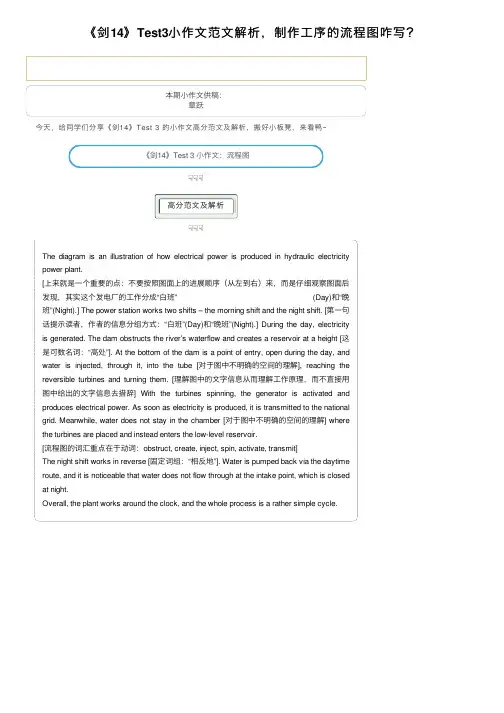
⾼分范⽂及解析The diagram is an illustration of how electrical power is produced in hydraulic electricity power plant.[上来就是⼀个重要的点:不要按照图⾯上的进展顺序(从左到右)来,⽽是仔细观察图⾯后发现,其实这个发电⼚的⼯作分成“⽩班” (Day)和“晚班”(Night).] The power station works two shifts – the morning shift and the night shift. [第⼀句话提⽰读者,作者的信息分组⽅式:“⽩班”(Day)和“晚班”(Night).] During the day, electricity is generated. The dam obstructs the river’s waterflow and creates a reservoir at a height [这是可数名词:“⾼处”]. At the bottom of the dam is a point of entry, open during the day, and water is injected, through it, into the tube [对于图中不明确的空间的理解], reaching the reversible turbines and turning them. [理解图中的⽂字信息从⽽理解⼯作原理,⽽不直接⽤图中给出的⽂字信息去措辞] With the turbines spinning, the generator is activated and produces electrical power. As soon as electricity is produced, it is transmitted to the national grid. Meanwhile, water does not stay in the chamber [对于图中不明确的空间的理解] where the turbines are placed and instead enters the low-level reservoir.[流程图的词汇重点在于动词:obstruct, create, inject, spin, activate, transmit]The night shift works in reverse [固定词组:“相反地”]. Water is pumped back via the daytime route, and it is noticeable that water does not flow through at the intake point, which is closed at night.Overall, the plant works around the clock, and the whole process is a rather simple cycle.。
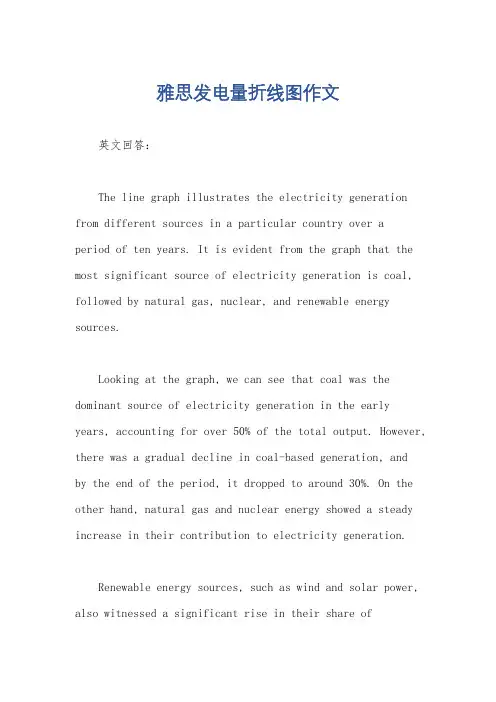
雅思发电量折线图作文英文回答:The line graph illustrates the electricity generation from different sources in a particular country over aperiod of ten years. It is evident from the graph that the most significant source of electricity generation is coal, followed by natural gas, nuclear, and renewable energy sources.Looking at the graph, we can see that coal was the dominant source of electricity generation in the early years, accounting for over 50% of the total output. However, there was a gradual decline in coal-based generation, andby the end of the period, it dropped to around 30%. On the other hand, natural gas and nuclear energy showed a steady increase in their contribution to electricity generation.Renewable energy sources, such as wind and solar power, also witnessed a significant rise in their share ofelectricity generation. Although they started at a low level, their contribution increased steadily and by the end of the period, they accounted for nearly 20% of the total electricity generation.Overall, the graph indicates a shift towards cleanerand more sustainable energy sources over the years,reflecting a global trend towards reducing carbon emissions and promoting environmental sustainability.中文回答:这张折线图展示了一个特定国家在十年内不同能源的发电量。
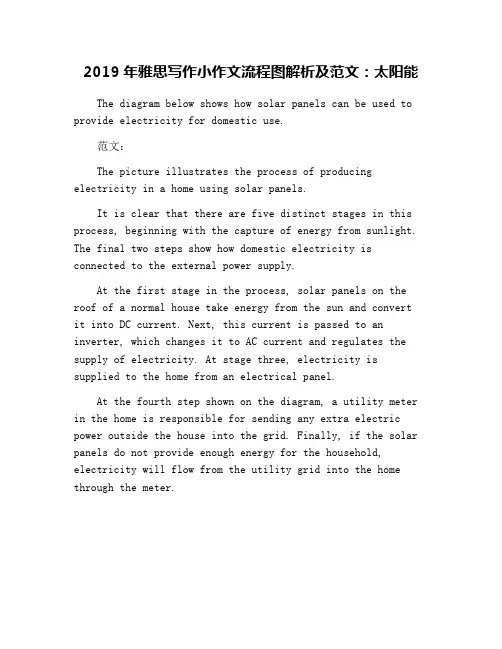
2019年雅思写作小作文流程图解析及范文:太阳能The diagram below shows how solar panels can be used to provide electricity for domestic use.范文:The picture illustrates the process of producing electricity in a home using solar panels.It is clear that there are five distinct stages in this process, beginning with the capture of energy from sunlight. The final two steps show how domestic electricity is connected to the external power supply.At the first stage in the process, solar panels on the roof of a normal house take energy from the sun and convert it into DC current. Next, this current is passed to an inverter, which changes it to AC current and regulates the supply of electricity. At stage three, electricity is supplied to the home from an electrical panel.At the fourth step shown on the diagram, a utility meter in the home is responsible for sending any extra electric power outside the house into the grid. Finally, if the solar panels do not provide enough energy for the household, electricity will flow from the utility grid into the home through the meter.。
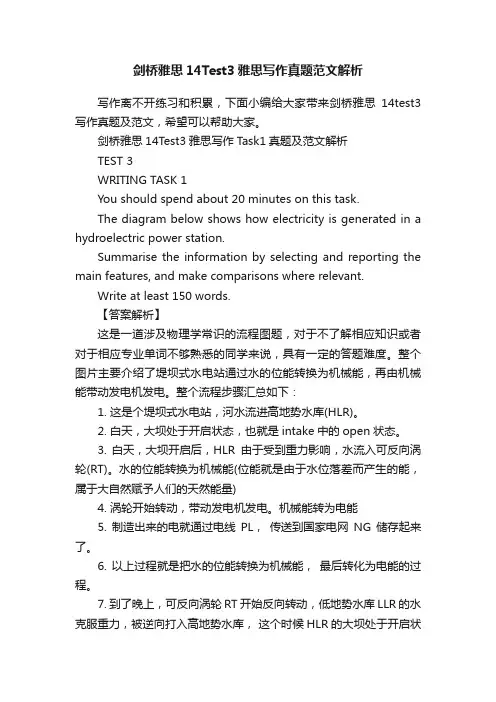
剑桥雅思14Test3雅思写作真题范文解析写作离不开练习和积累,下面小编给大家带来剑桥雅思14test3写作真题及范文,希望可以帮助大家。
剑桥雅思14Test3雅思写作Task1真题及范文解析TEST 3WRITING TASK 1You should spend about 20 minutes on this task.The diagram below shows how electricity is generated in a hydroelectric power station.Summarise the information by selecting and reporting the main features, and make comparisons where relevant.Write at least 150 words.【答案解析】这是一道涉及物理学常识的流程图题,对于不了解相应知识或者对于相应专业单词不够熟悉的同学来说,具有一定的答题难度。
整个图片主要介绍了堤坝式水电站通过水的位能转换为机械能,再由机械能带动发电机发电。
整个流程步骤汇总如下:1. 这是个堤坝式水电站,河水流进高地势水库(HLR)。
2. 白天,大坝处于开启状态,也就是intake中的open状态。
3. 白天,大坝开启后,HLR由于受到重力影响,水流入可反向涡轮(RT)。
水的位能转换为机械能(位能就是由于水位落差而产生的能,属于大自然赋予人们的天然能量)4. 涡轮开始转动,带动发电机发电。
机械能转为电能5. 制造出来的电就通过电线PL,传送到国家电网NG储存起来了。
6. 以上过程就是把水的位能转换为机械能,最后转化为电能的过程。
7. 到了晚上,可反向涡轮RT开始反向转动,低地势水库LLR的水克服重力,被逆向打入高地势水库,这个时候HLR的大坝处于开启状态。
8. 逆向泵水的过程结束后,大坝关闭,这一天的水又回到HLR,等待第二天重复以上全过程。
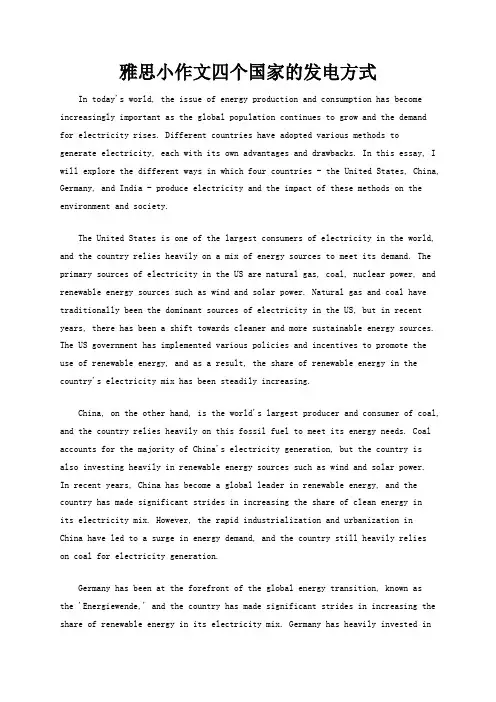
雅思小作文四个国家的发电方式In today's world, the issue of energy production and consumption has become increasingly important as the global population continues to grow and the demandfor electricity rises. Different countries have adopted various methods togenerate electricity, each with its own advantages and drawbacks. In this essay, I will explore the different ways in which four countries - the United States, China, Germany, and India - produce electricity and the impact of these methods on the environment and society.The United States is one of the largest consumers of electricity in the world, and the country relies heavily on a mix of energy sources to meet its demand. The primary sources of electricity in the US are natural gas, coal, nuclear power, and renewable energy sources such as wind and solar power. Natural gas and coal have traditionally been the dominant sources of electricity in the US, but in recent years, there has been a shift towards cleaner and more sustainable energy sources. The US government has implemented various policies and incentives to promote the use of renewable energy, and as a result, the share of renewable energy in the country's electricity mix has been steadily increasing.China, on the other hand, is the world's largest producer and consumer of coal, and the country relies heavily on this fossil fuel to meet its energy needs. Coal accounts for the majority of China's electricity generation, but the country is also investing heavily in renewable energy sources such as wind and solar power.In recent years, China has become a global leader in renewable energy, and the country has made significant strides in increasing the share of clean energy inits electricity mix. However, the rapid industrialization and urbanization inChina have led to a surge in energy demand, and the country still heavily relieson coal for electricity generation.Germany has been at the forefront of the global energy transition, known asthe 'Energiewende,' and the country has made significant strides in increasing the share of renewable energy in its electricity mix. Germany has heavily invested inwind and solar power, and renewable energy sources now account for a significant portion of the country's electricity generation. The German government has implemented various policies and incentives to promote the use of renewable energy, and as a result, the country has made significant progress in reducing itsreliance on fossil fuels for electricity generation.India, as a rapidly developing country, faces significant challenges in meeting its growing energy demand while also addressing environmental concerns. The country heavily relies on coal for electricity generation, and coal accountsfor the majority of India's electricity production. However, India has also been investing in renewable energy sources such as solar and wind power, and thecountry has set ambitious targets to increase the share of clean energy in its electricity mix. The Indian government has implemented various policies and incentives to promote the use of renewable energy, and as a result, the countryhas made significant progress in increasing the share of clean energy in its electricity generation.In conclusion, the four countries discussed in this essay - the United States, China, Germany, and India - have adopted different methods to generate electricity, each with its own advantages and drawbacks. While the US and Germany have made significant progress in increasing the share of renewable energy in theirelectricity mix, China and India still heavily rely on coal for electricity generation. As the global population continues to grow and the demand forelectricity rises, it is crucial for countries to prioritize clean and sustainable energy sources to mitigate the environmental impact of electricity production.。
水蒸气发电流程图英语作文英文回答:Steam Power Plant Process Flow Diagram.A steam power plant is a thermal power plant that uses steam to drive a turbine which is connected to a generator to produce electricity. The steam is generated by heating water in a boiler. The general process flow diagram of a steam power plant is as follows:1. Fuel: Coal, natural gas, or other fuels are burned in a boiler to generate heat.2. Boiler: The heat from the boiler is used to convert water into steam.3. Superheater: The steam from the boiler is superheated to increase its temperature and pressure.4. Turbine: The superheated steam is directed to a turbine, which converts the thermal energy of the steaminto mechanical energy.5. Condenser: After passing through the turbine, the steam is condensed back to water in a condenser.6. Pump: The condensed water is pumped back to the boiler to be reused.7. Cooling Tower: The cooling tower is used to cool the water from the condenser.8. Generator: The mechanical energy from the turbine is used to drive a generator, which produces electricity.9. Transformer: The electricity from the generator is stepped up to higher voltage levels for transmission.中文回答:水蒸气发电流程图。
雅思流程图用煤生产清洁能源范文After the Industrial Revolution, the nation who conquers the energy world will conquer the world at the same time. Some people believe that traditional fuels, including coal,oil, and gas, are the main sources rather than alternative sources like wind energy and solar energy. Personally, the use of alternative sources of energy should be encouraged and spread all over the world.Admittedly, fossil fuels as the main sources make human beings live more effectively and efficiently.A large amount of energy in fossil fuels is applied to the industrial production and it seems that the process of making energy from fossil fuels is employed by most countries. Nonetheless, traditional resources will dry up in a foreseeablefuture.Human beings must find an alternative way to continue civilization.The advantages of alternative sources of the energy can be divided into two aspects:Firstly, using alternative sources reduce the contamination of the environment. Namely,most new energies are green. Secondly, alternative sources of energy that are regarded as sustainable sources of energy are more likely to meet the massive demands of economic and cultural development in modern society. However, it is often considered that using alternative sources of energy such as nuclear energy is a quite dangerous thing for human beings and our planet.CSome other alternative sources of energy like wind energy and solar energy are not quite available for production for the sake of expensive payment.To conclude, the use of the alternative sources may contribute to social development and push the whole world into a new dynasty, which does no harm to the environment and has high effectiveness. Only by this can we break through the bottleneck of the energy crisis.。
火力发电流程图英语作文The Process of Thermal Power Generation.Thermal power generation, also known as coal-fired power generation, is a widely used method of producing electricity across the globe. It involves converting heat energy into electrical energy, primarily through the use of steam turbines. While the process may vary slightly depending on the specific plant and technology used, the fundamental steps remain the same. This article outlines the key stages involved in thermal power generation.1. Fuel Combustion.The process begins with the combustion of fuel, typically coal, but also including other fossil fuels like oil or natural gas. In a coal-fired power plant, coal is fed into a boiler or furnace, where it is burned at high temperatures. This combustion releases heat energy, which is absorbed by water circulating through the boiler.2. Steam Generation.The heat from the combustion process causes the water to boil and turn into steam. This steam, under high pressure, is then directed to the turbine. The pressure and temperature of the steam are carefully controlled to ensure maximum efficiency and safety.3. Turbine Rotation.The steam enters the turbine, which consists of a series of rotating blades. The force of the expanding steam against these blades causes the turbine to rotate. This rotation is what converts the heat energy into mechanical energy.4. Generator Operation.The rotating turbine is connected to an electrical generator. As the turbine turns, it spins a magnetic field within the generator, inducing an electrical current in thegenerator's windings. This current is then directed through transformers to increase its voltage, ready for transmission to the power grid.5. Steam Condensation and Recycling.After passing through the turbine, the steam is cooled and condensed back into water. This water is then pumped back into the boiler to start the cycle again, completing the closed-loop system.6. Flue Gas Treatment.During the combustion process, flue gases containing carbon dioxide and other pollutants are released. These gases must be treated to comply with environmental regulations before being discharged into the atmosphere. Processes like desulfurization and dust removal are employed to reduce harmful emissions.7. Efficiency and Emissions Monitoring.Thermal power plants are equipped with a range of monitoring systems to ensure efficient operation and minimize emissions. These systems constantly monitor parameters like fuel consumption, steam pressure and temperature, and emissions levels. Any deviations from optimal operating conditions can be quickly identified and addressed.8. Power Transmission and Distribution.The electrical power generated by the plant is transmitted through high-voltage transmission lines to distribution centers. Here, the power is stepped down to lower voltages suitable for distribution to residential and commercial customers.Thermal power generation is a complex process that requires careful management and monitoring. It involves converting chemical energy stored in fossil fuels into heat, then converting that heat into mechanical energy through steam turbines, and finally converting that mechanical energy into electricity. While it remains a significantsource of power generation worldwide, it also presents environmental challenges that need to be addressed through sustainable practices and technology advancements.。
雅思流程图水力发电站范文下载温馨提示:该文档是我店铺精心编制而成,希望大家下载以后,能够帮助大家解决实际的问题。
文档下载后可定制随意修改,请根据实际需要进行相应的调整和使用,谢谢!并且,本店铺为大家提供各种各样类型的实用资料,如教育随笔、日记赏析、句子摘抄、古诗大全、经典美文、话题作文、工作总结、词语解析、文案摘录、其他资料等等,如想了解不同资料格式和写法,敬请关注!Download tips: This document is carefully compiled by theeditor. I hope that after you download them,they can help yousolve practical problems. The document can be customized andmodified after downloading,please adjust and use it according toactual needs, thank you!In addition, our shop provides you with various types ofpractical materials,such as educational essays, diaryappreciation,sentence excerpts,ancient poems,classic articles,topic composition,work summary,word parsing,copy excerpts,other materials and so on,want to know different data formats andwriting methods,please pay attention!1. 水库,收集和储存水。
2. 进水口,将水引入管道或运河。
电的流程图英语作文Electric energy is the most important energy,as well as other energy production and consumption of energy products.At present,China's energy consumption is far greater than that of developed countries,but China's per capita GDP is very low,and our economic growth mode must be transformed from extensive to intensive.From the perspective of sustainable development,energy is one of the most important components.We must try our best to save energy and reduce our natural non renewable to future generations by saving energy Resource requirements.If there is no electric light,it is difficult for people to imagine.In modern society without electric light,it will be very difficult for people to imagine the era when there is no electric light,and it will be very difficult for people to see the era when the light is flashing and the food is decaying in the silent refrigerator.However,it was only more than two centuries ago that people began to understand how electricity works.Obviously,nature has been experimenting in this field for millions of years.More and more scientists have found that theliving world may contain many interesting secrets of electricity.These secrets can benefit human beings.When the heart beats,living cells send out tiny electric pulses,which send out recording pulses and form electrocardiogram.Doctors can study electrocardiogram to determine the working condition of the heart,and the brain can also send out brain waves,and most of them can be recorded in EEG The current cells produced by living people are very small,usually very small,and sensitive instruments are needed to record them.But in some animals,some muscle cells have become very specialized.When these cells are connected in large numbers,they do not function as muscle cells at all.The effect is amazing.The electric eel is a kind of amazing battery,which can pass through the water it lives in It produces up to 800 Volts of electricity(an electric eel has only 120 volts,whereas four fifths of its batteries are dedicated to generating electricity,and the impact strength it can deliver is roughly the length of its body.When you go to work in the morning and find that the traffic lights are not on,traffic jams will certainly happen.The patient needs immediate surgery.What happens if surgery cannotbe performed because of a power failure?We can't watch TV or listen to tapes.Chatting online is closely related to our daily life.It would be terrible without electricity.。
You should spend about 20 minutes on this task.
The diagram below shows how geothermal energy is used to produce electricity.
Summarise the information by selecting and reporting the main features, and make comparisons where relevant.
Write at least 150 words.
The diagram shows that there are five main stages in the production of electricity through the use of geothermal energy.
The process begins with cold water being pumped from the surface of the earth down into a
4.5 kilometer-deep injection well. From there, it is transferred to the geothermal zone, a subterranean region composed of hot rocks, before reaching the production well, which is a vertical pipe similar to the injection well but a bit wider.
In the stage that follows, the hot water is pumped up through the production well into a condenser on the surface where it is converted into steam, following which it is used to power a turbine and rotate it. This turbine is connected to an electricity generator which, when rotated by the turbine, produces electricity. The process ends when the electricity generated by the generator is transferred to the power grid for consumption by end users.
(152 words)。